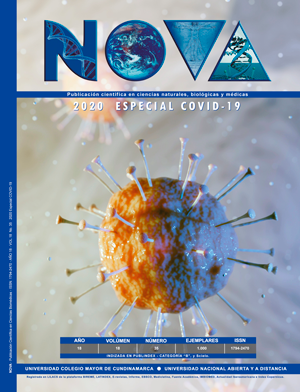NOVA por http://www.unicolmayor.edu.co/publicaciones/index.php/nova se distribuye bajo una licencia Reconocimiento No Comercial- Compartir igual
Así mismo, los autores mantienen sus derechos de propiedad intelectual sobre los artículos,
Declaración de privacidad.
Los nombres y las direcciones de correo electrónico introducidos en esta revista se usarán exclusivamente para los fines establecidos en ella y no se proporcionarán a terceros o para su uso con otros fines.
Hematological Findings in COVID-19
Severe Acute Respiratory Syndrome (SARS) is the serious condition of coronavirus (COVID-19) caused by SARS-COV-2 which causes respiratory infections in humans, and whose transmission is given mainly through the contact. this virus enters into the host cell due to the spike protein (S) interaction with the angiotensin-converting enzyme 2 (ACE2), which is not only present in the respiratory tract but also monocytes, macrophages, endothelial cells, the heart, and gastrointestinal tract. The increase in INF stops viral replication and activates the adaptive immune response. The infection's clinic manifestations often occur in the respiratory tract; however, other systems like the hematopoietic may be affected. Altered cell counts, mainly leukocytes and platelets, are seen on the blood count. Lymphopenia and neutrophilia are associated with severe disease; thrombocytopenia is present in a heterogeneous way in the infection. Among the disease's complications are the Disseminated Intravascular Coagulation (DIC) that results when monocytes and endothelial cells are activated because of the release of cytokines, causing endothelial damage, with the synthesis of the tissue factor, tissue factor discharge, platelet activation, and the von Willebrand factor release, generating a hyperfibrinolytic condition especially in the infection's late-stage. Laboratory tests such as D-dimer (D-D), Fibrinogen Degradation Products (FDP), Prothrombin Time (PT), Activated Partial Thromboplastin Time (APTT) among others, are essential to the diagnosis, monitoring, and prognosis of the disease.









